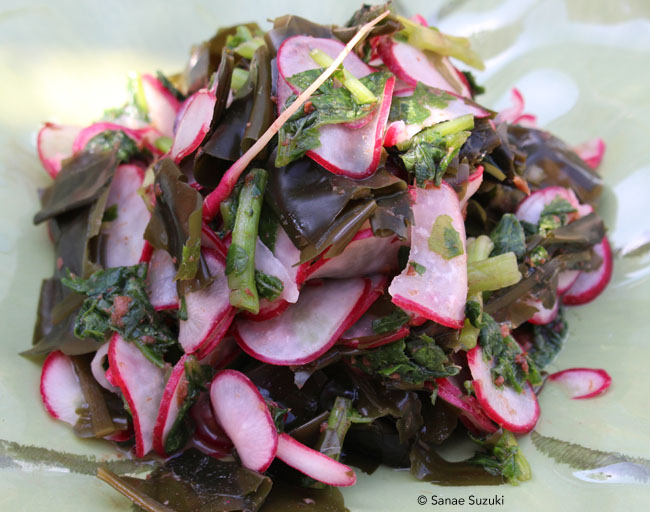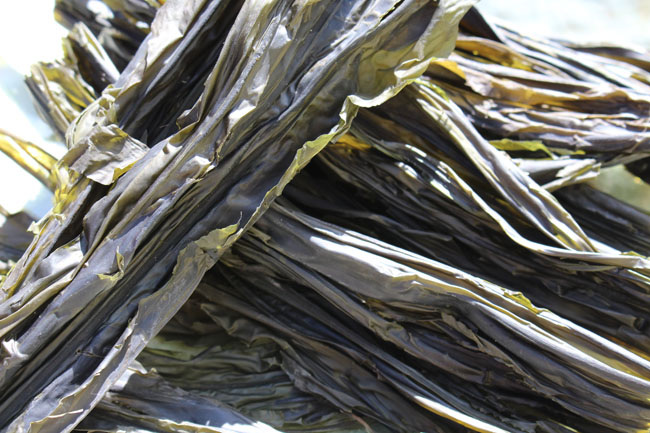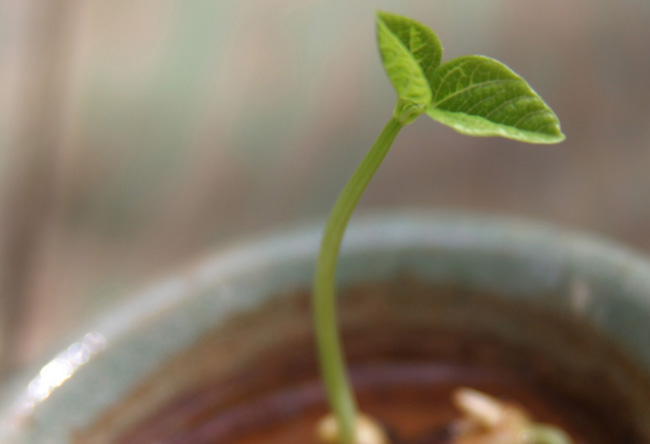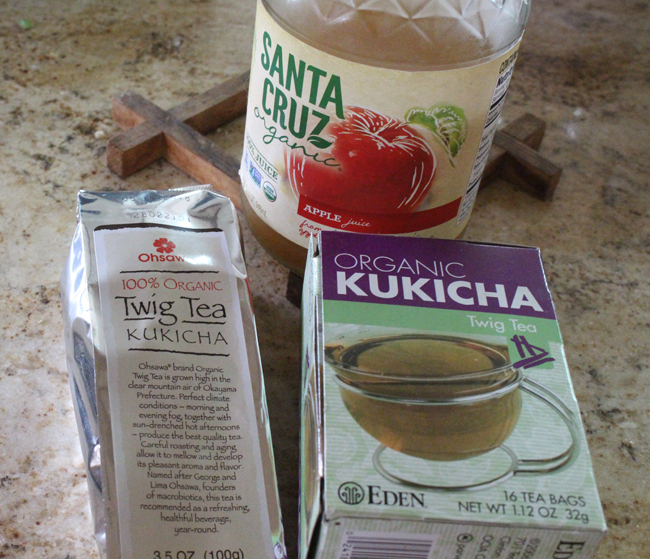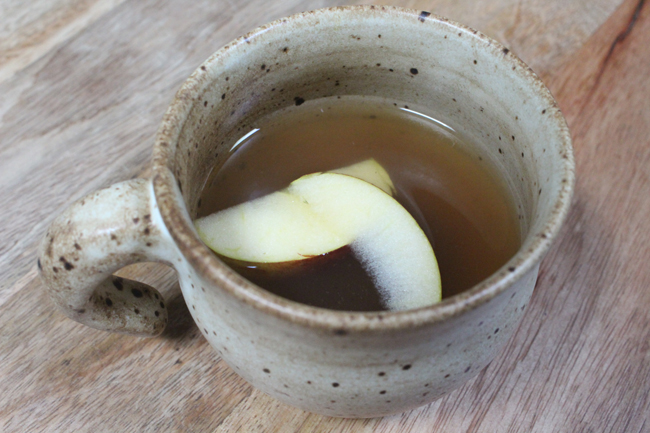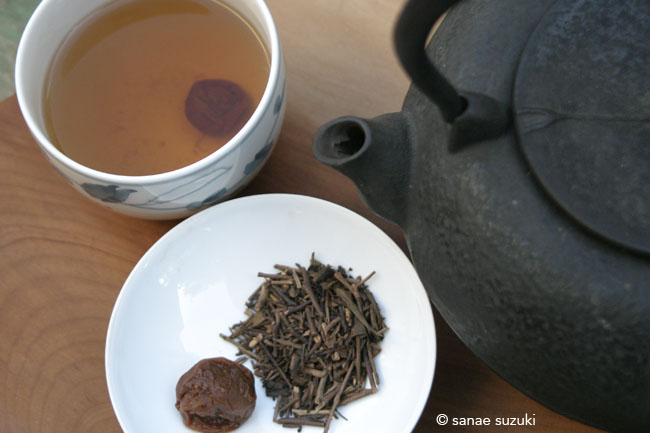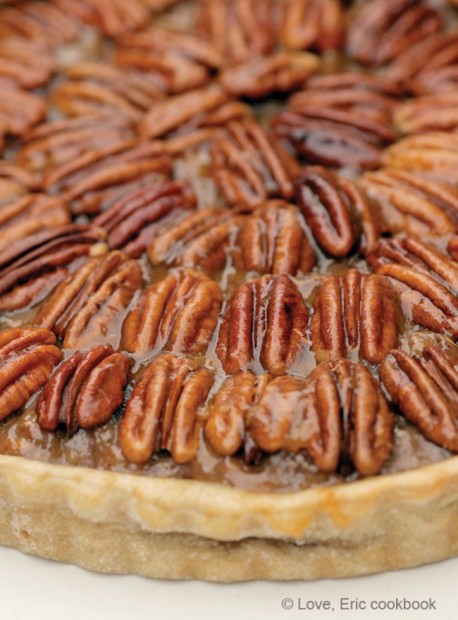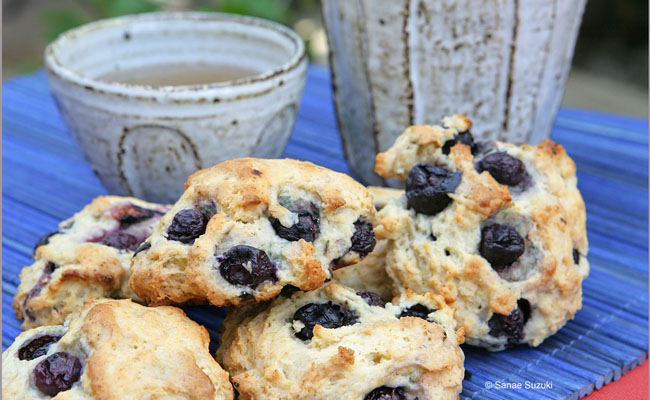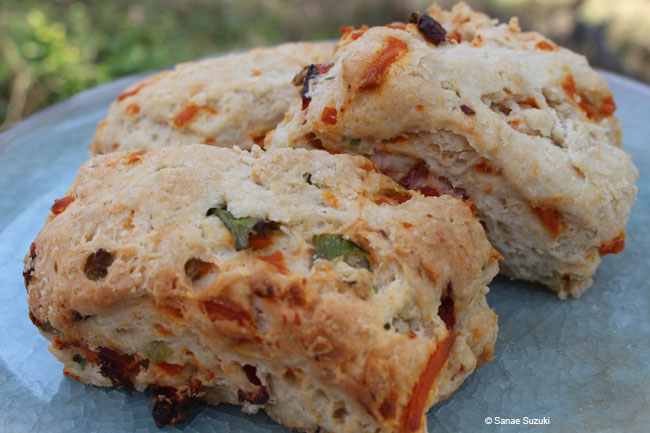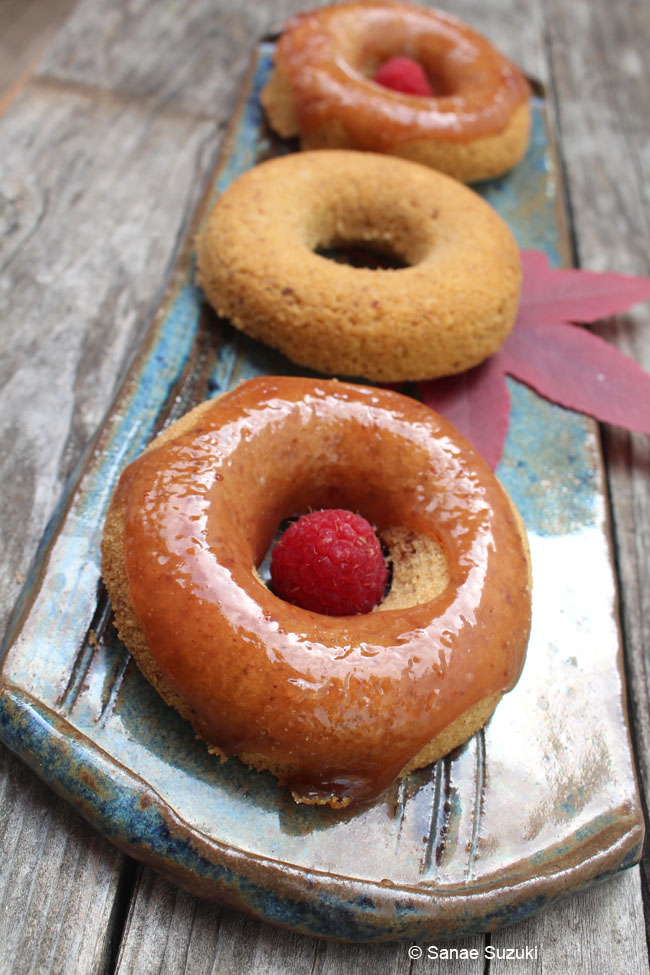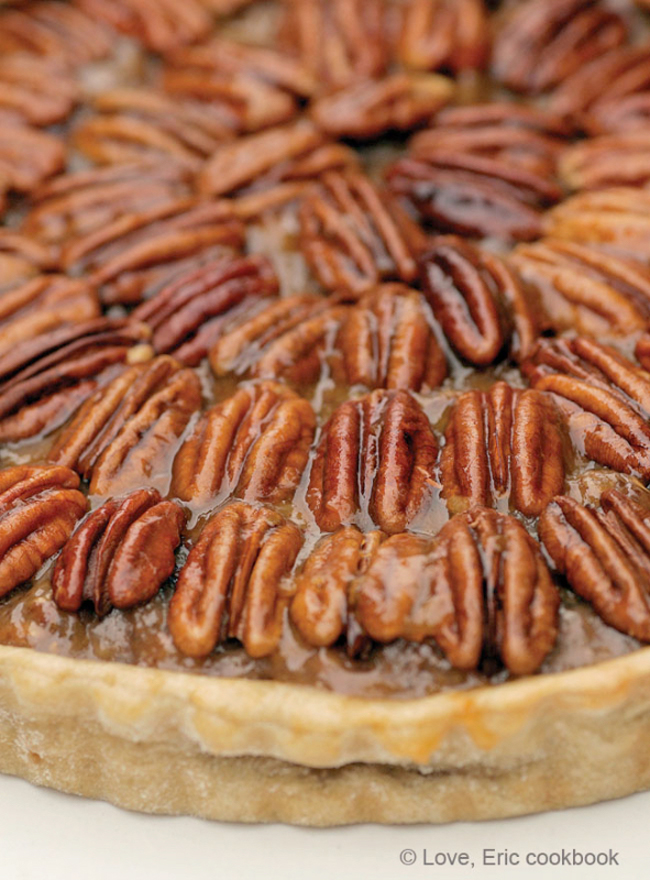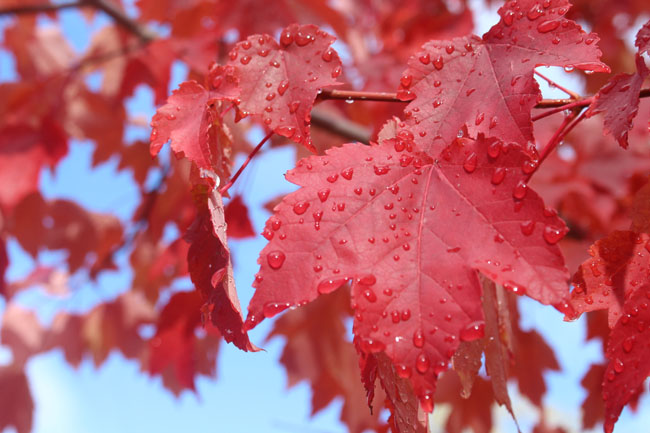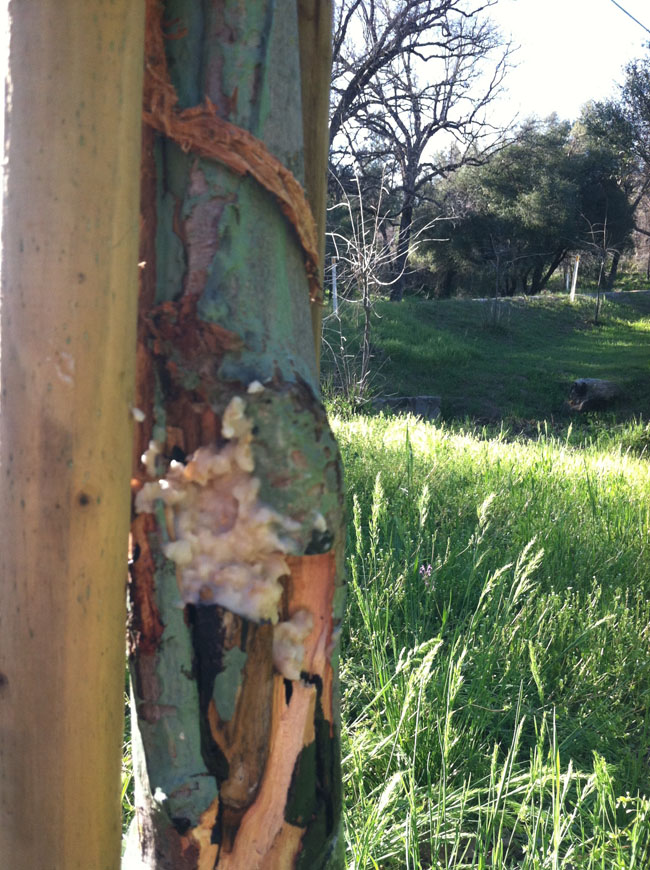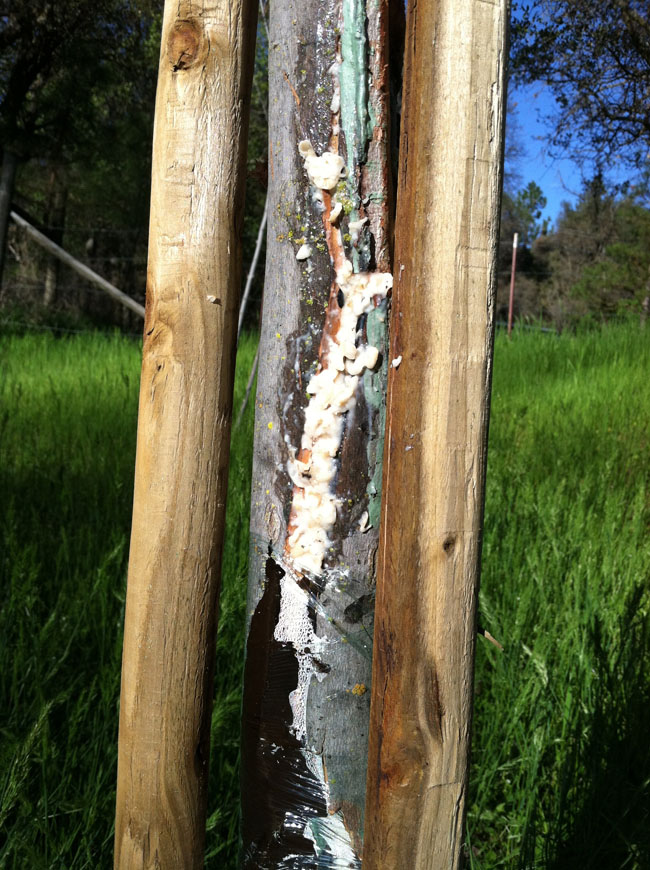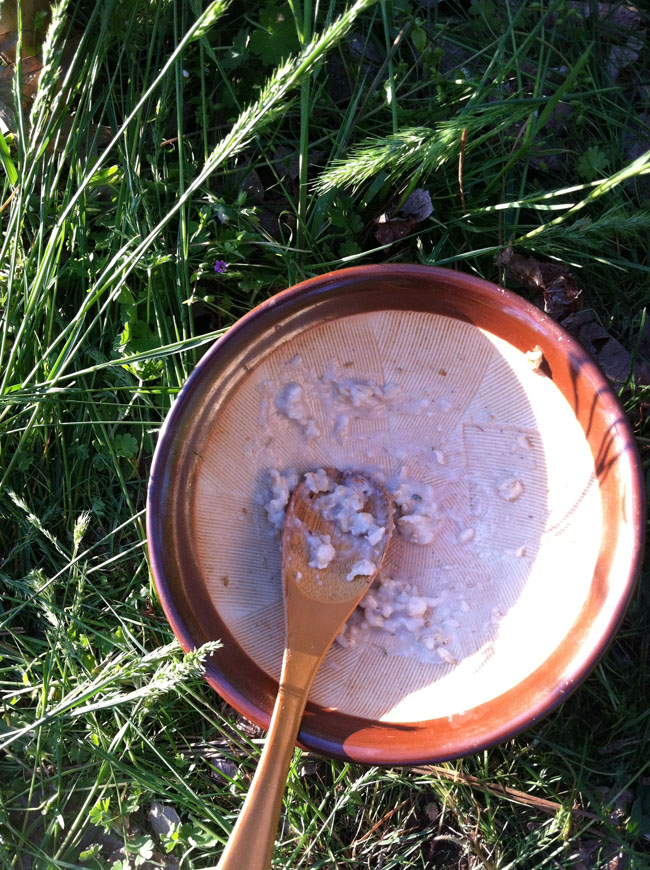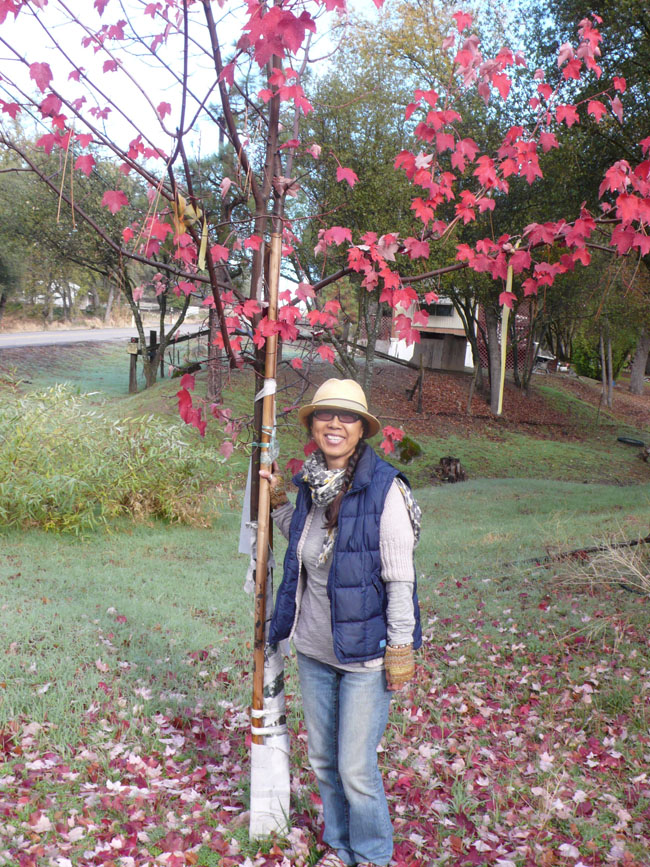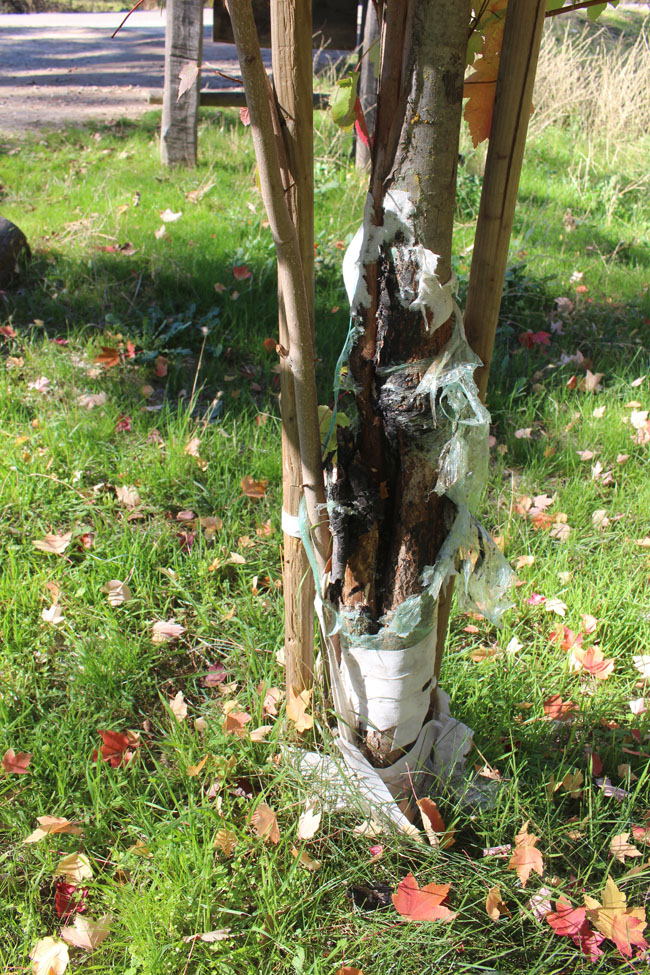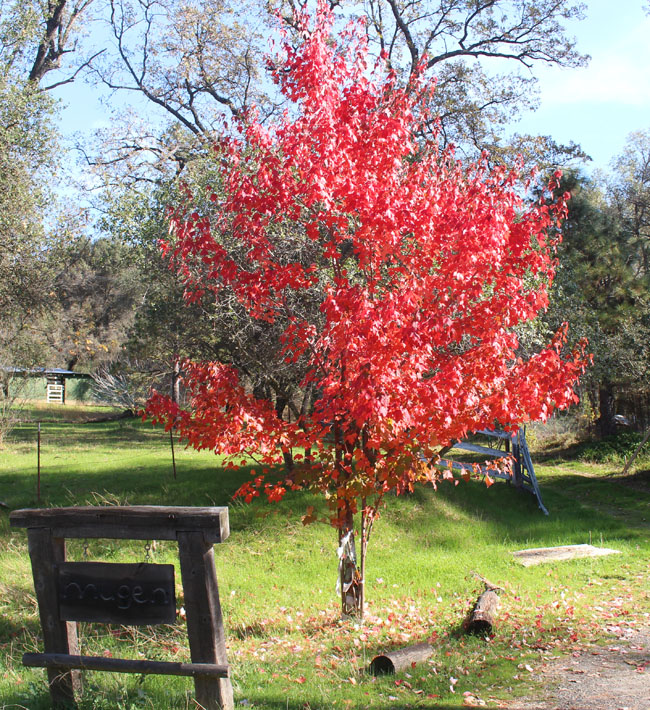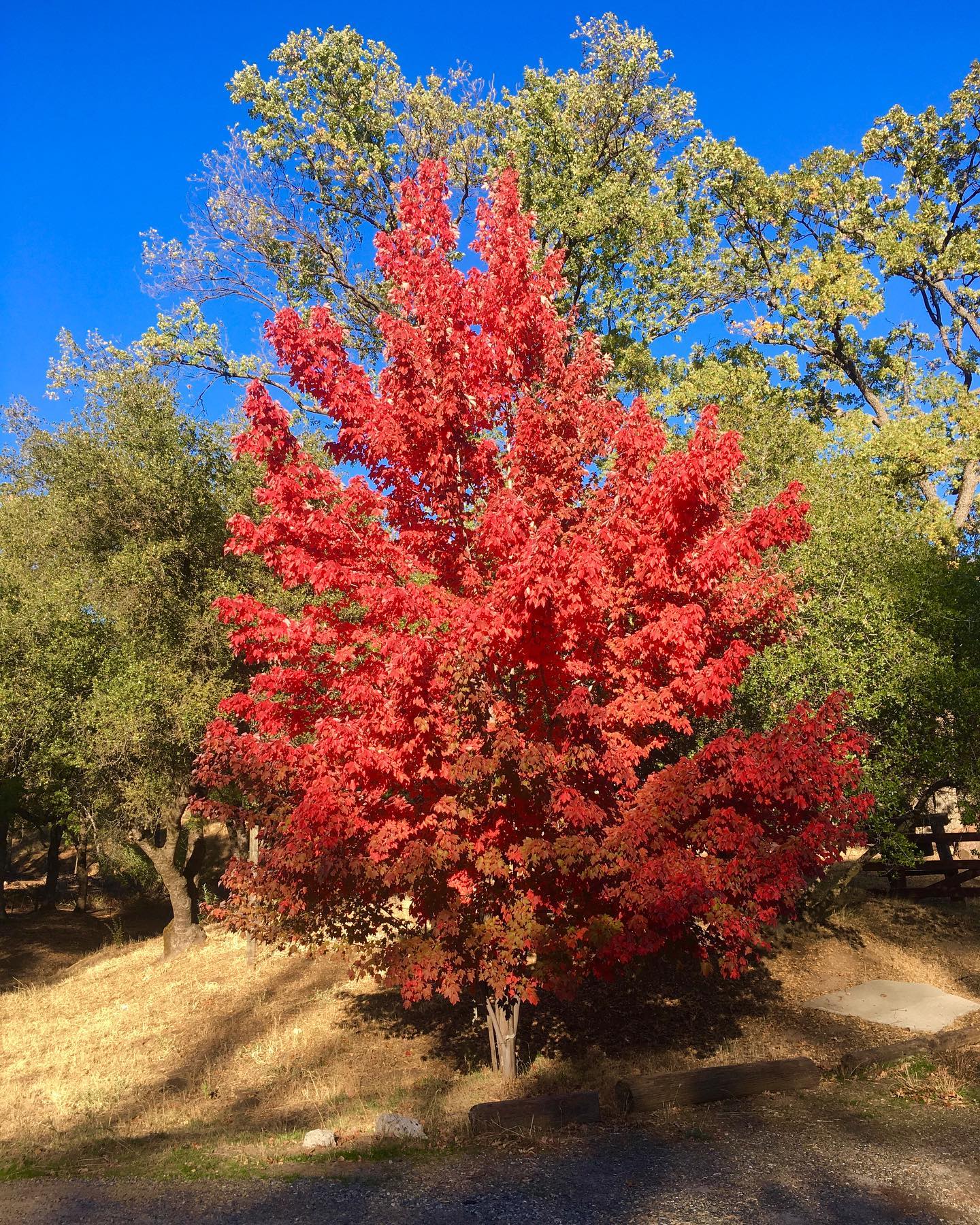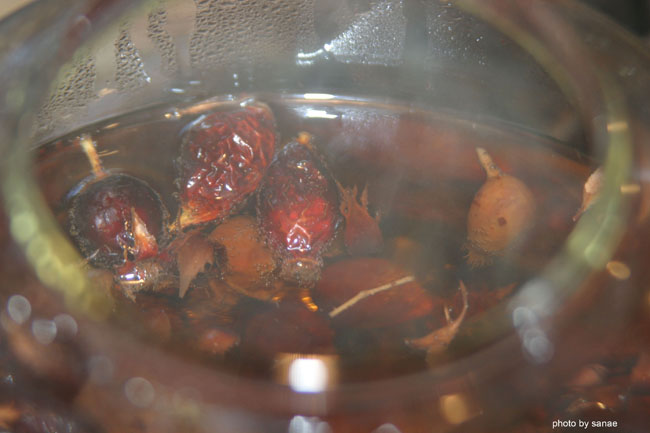
Roses were not my favorite flowers till I was 14 years old, so I never grew them till later in my life. But when I was 7 or 8 years old, I saw rose bushes for the first time. I noticed that there were red balls that could be fruits or a seed of the flowers. As a curious girl, I had to pick it and put it in my mouth. It was kind of sour tasting with a hint of sweetness, but it was not sweet enough for me, being a child who loved sugary food and dessert at that time. So, I didn’t think about it for a long time, and I just enjoyed roses as beautiful flowers.
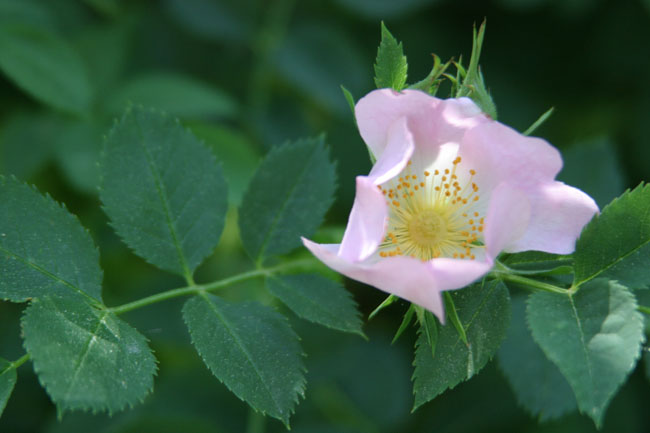
Wild rose flower in North Fork, California.
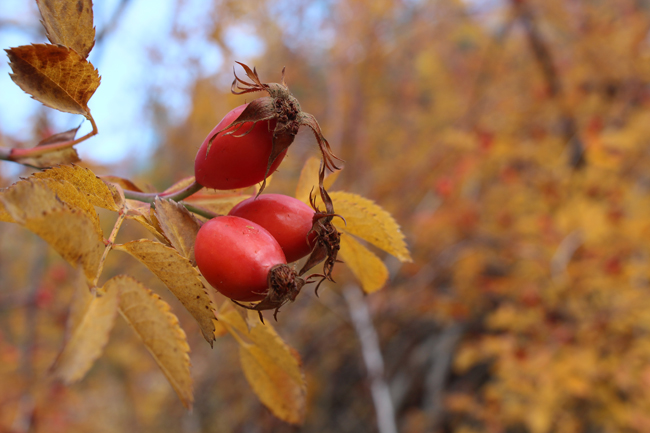
Wild Rosehips in North Fork, California.
I started to make different healing teas when I took an herbology class from David Craw (founder of Learning Garden in Venice, CA and Floracopeia) in 1998 at California Healing Arts College. David harvested wild native herbs before the class, and we made tea and learned the benefits of the herbs and how they have been helping humans’ health for a long time. It was fascinating to me, and I learned so much about how plants and herbs can help us. Because of this class, I got more curious about making all kinds of herbal tea and flower tea, since I love tea so much. Later on, I found out rosehips are the seeds of rose flowers, and my childhood memory of that sour taste, with a hint of sweetness of the fruits, came back to me.
I got curious again and found so many benefits of rosehips by making tea, jelly, jam, soup, oil, etc. Rose plants do not just produce beautiful flowers; I think they are medicinal plants that can fit in the herbs and spices category.
Wikipedia says: “In general use, herbs are any plants used for food, flavoring, medicine, or fragrances for their savory or aromatic properties. Culinary use typically distinguishes herbs from spices. Herbs refer to the leafy green or flowering parts of a plant (either fresh or dried), while spices are produced from other parts of the plant (usually dried), including seeds, berries, bark, roots and fruits.”

Wild rosehips bush. You can see Eric and Leo standing by the bish, how big this rose bush is.
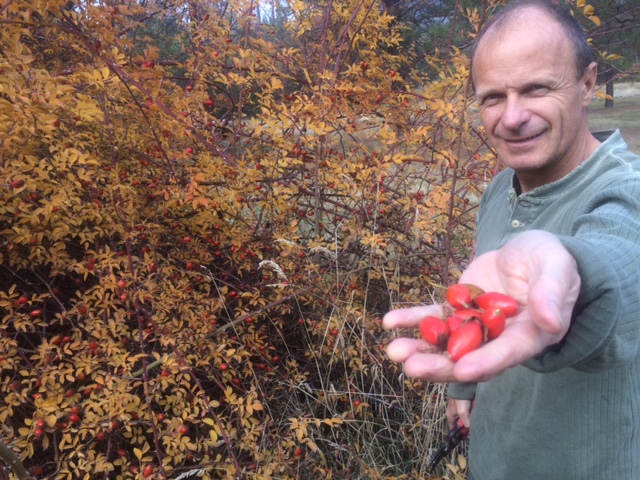
Big rosehips!
I found wild big rose bushes when Eric and I started to go to North Fork, California, in 2004. I noticed they produced big rosehips every year, from around Thanksgiving to the end of the year. So, we have been harvesting fresh, wild rosehips every year and have been making the tea. Its sour and naturally sweet taste are soothing to me since I’ve matured and do not eat sugary food or dessert anymore. I have offered North Fork rosehip tea to our friends many times. They’ve usually never had rosehip tea before, but everyone loves it. I love its pink to reddish color. It is perfect to serve for the holiday season.
As an end-of-year gratitude/gift (in Japan, we call it Oseibo) for people who read my blog, I want to share my rosehip tea recipe. I hope you enjoy making it, enjoy the taste, and also get the benefits of the tea.
WHERE TO PURCHASE ROSEHIPS
Whole Rosehips
Seedless Rosehips
Tea Bags
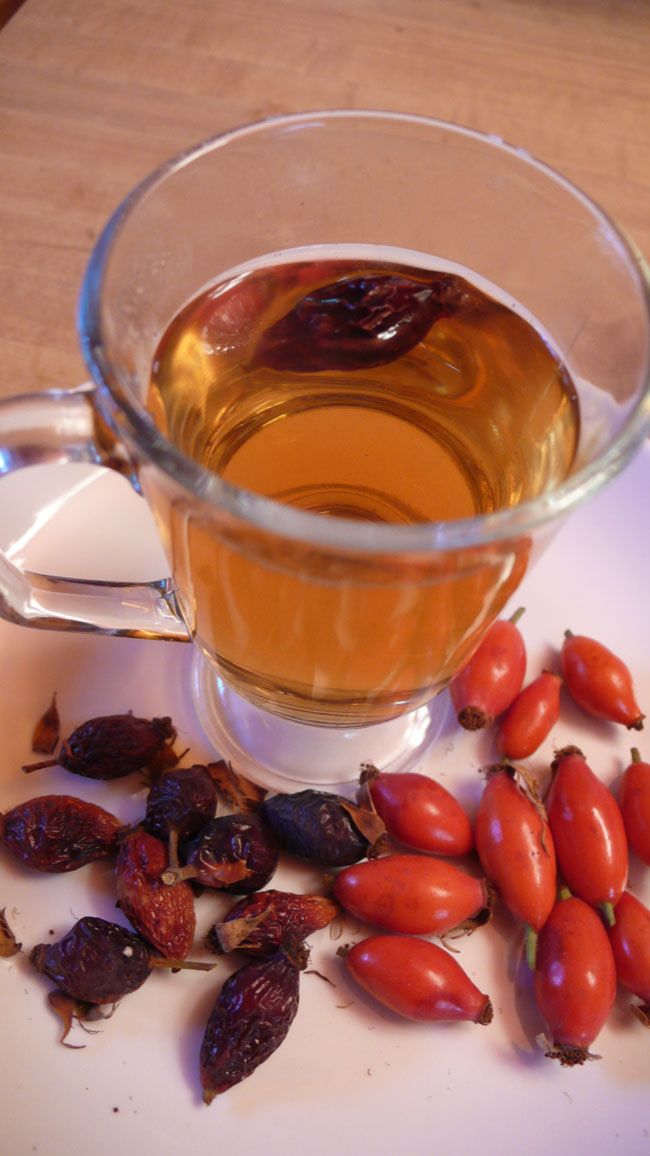
Rosehips tea with dried rosehips and fresh rosehips.
ROSEHIP TEA RECIPE
Ingredients
- 4 tablespoons dried rosehips (whole ) or 4 teaspoons dried rosehip (crushed/cut/sifted)
- 4 cups water (filtered)
- Brown rice syrup or maple syrup (optional)
- Add the rosehips to a stainless steel or glass pot (make sure the pot can be put directly on the stove), along with the water.
- Slowly bring the mixture to a boil, and then reduce it to a simmer for depending on how strong you want to make the tea. I usually simmer for 15 ~ 30 minutes for whole rosehips and 5–15 minutes for crushed/cut/sifted rosehips.
- Remove from the heat, and pour it into your favorite cup.
- I like the tea as-is, but if desired, you can add 1 teaspoon brown rice syrup or maple syrup for sweetness.
- Enjoy!
I rotate between drinking rosehip tea a few times a week for a while, and then stopping and drinking Elderberry Tea (my blog) and/or Kukicha (my blog).
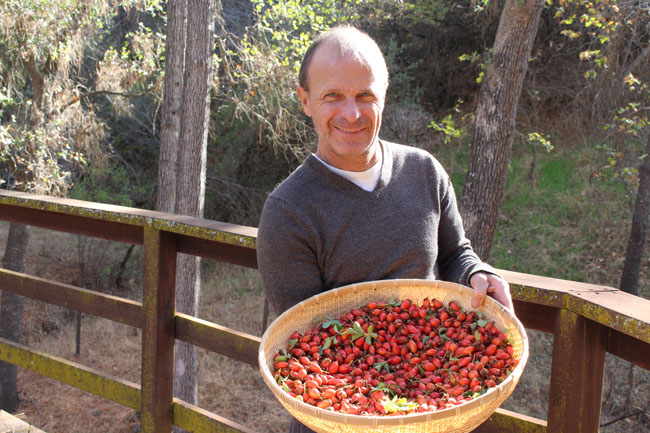
It was a good harvesting of rosehips!
BENEFITS
Rosehips have many benefits. Here are just some of the health conditions they help alleviate: weakened immune system, skin conditions, chronic pain, indigestion, high toxicity levels, arthritis, gout, inflammatory conditions, high cholesterol, hypertension, and increased risk of heart disease or cancer (reference: Style Craze, Organic Facts).
Strengthens Immunity
The rosehips are extremely high in vitamin C, which can pack a major punch for a better immune system. It will increase your white blood cell count and stimulate growth, especially if you are recovering from an injury, illness or surgery.
Skin Care
Many people drink rosehip tea to improve the appearance of the skin, as this herbal blend is known to be astringent in nature, while also delivering those powerful antioxidants to the areas of the skin that need it most. This can help reduce the appearance of lines and wrinkles, speed healing of irritated or dry skin, and prevent infections and inflammation, such as flare-ups of psoriasis, eczema, and acne.
Acts as an Analgesic
The carotenoids and flavonoids found in rosehip tea have analgesic properties, making this tea a great pain reliever. Whether it is chronic pain of arthritis or acute pain of injuries or sprains, the anti-inflammatory and analgesic properties can work very quickly.
Reduces Inflammation
Studies done on rheumatoid arthritis and osteoarthritis showed that rosehip tea can significantly improve mobility and reduce inflammation, improving the quality of life and lowering oxidative stress in those inflamed tissues. This is also helpful for digestion, as these anti-inflammatory properties can soothe the tissues in the gut while regulating bowel movements and ensuring proper nutrient uptake.
Detoxifies the Body
Rosehip tea is known to have both laxative and diuretic properties, which can help the body eliminate toxins, and unwanted fats and salts in an efficient way. If you are struggling with constipation, low metabolism, or a weakened immune system, it can be a good idea to flush the toxins out and reduce the load on the kidneys and liver. This tea can help you do that by stimulating faster digestion and increasing the frequency of urination.
Help Prevent Rheumatoid Arthritis
In one study, patients who received rose hip showed greater improvements in arthritic conditions (18). In another study conducted back in 2008, rose hip powder had reduced pain in the hips, joints, and knees by about a third (19). The study was conducted on 300 osteoarthritis patients.
Rose hips also contain the fatty acid GOPO, which, as per experts, is the plant version of fish oil. And GOPO could be one of the contributing factors for the fruit’s anti-arthritic properties. Rosehip extract pills were found to reduce arthritic pain by as much as 90 percent (20). In fact, one popular arthritic medicine called LitoZin is made from processed ground rose hips.
Another important quality about rose hips (with respect to treating arthritic symptoms) is they don’t have ulcerogenic effects like certain other medications.
Additional Vitamin C Benefits
Rose hips are so full of vitamin C that the nutrient deserves a special mention. By the way, did you know that the fruit contains 60 times the vitamin C found in an orange?
One of the major benefits of vitamin C is collagen production. Collagen is a protein that forms the connective tissue in the body. The vitamin also treats inflammation and improves immunity. It prevents scurvy, a disease that can cause muscle weakness, joint pains, rashes, and tooth loss (14).
The vitamin C in rose hips also helps maintain the health of blood vessels. And because of the high levels of this vitamin, even the American Indian tribes had used the tea from the fruit to treat respiratory ailments (15).
Here’s a quick tip for you – when it comes to cooking rose hips (or any food rich in vitamin C), never use aluminum pans or utensils as they can destroy the vitamin in the food (16).
Vitamin C in rose hips also helps your body absorb iron better (17). Iron has several benefits, the major one being preventing anemia and keeping your blood healthy. And yes, vitamin C also treats and prevents cold and flu symptoms. So, you don’t have to worry even if the seasons are changing.
Lower Cholesterol
Regular intake of rose hip extract has been linked to lowered cholesterol levels (13). The fruit is particularly effective in obese patients – patients who consumed a drink made of rose hip powder daily for six weeks saw a significant drop in their total blood cholesterol levels by as much as 5 percent. This drop can even reduce the risk of heart disease by 17 percent. Rosehip can also be used as a safe alternative to anti-cholesterol drugs (like statins) that might have side effects.
Prevents Cardiovascular Diseases
There is a large body of research into the cardiovascular impact of rosehips, primarily due to the high levels of antioxidants present in these fruits. Specifically, studies have shown that leucoanthocyanins and polyphenolic compounds in rosehip tea can lower the risk of heart disease. This tea is also rich in lycopene, which has been directly linked to lower the occurrences of cardiovascular diseases.
Prevents Cancer
Many of the antioxidants in rosehip tea are praised for their anti-cancer abilities, as they are able to seek out and neutralize free radicals before they can cause oxidative stress, and can make it more difficult for cancerous cells to multiply, generate energy, and continue attacking the body. Research on the link between cancer and rosehips is ongoing, but early results show a very promising connection.
If you’re pregnant, breastfeeding, or on medication, please consult with your doctor before drinking rosehip tea.
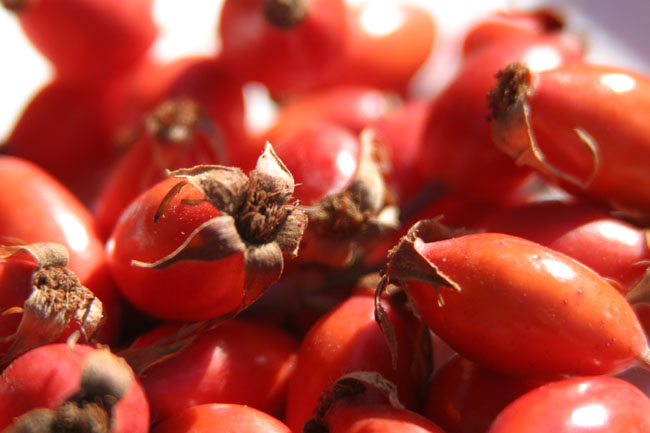
Jewel of rosehips.
Love,
Sanae 💖

